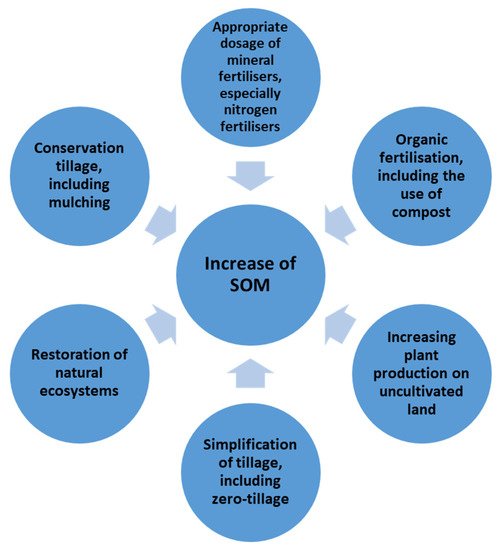Soil degradation is the modification of its physical, chemical and biological properties that worsen the biological activity of the environment, with particular emphasis on food production, water quality, ecosystem services, flooding, eutrophication, biodiversity and carbon stock shrinkage. Soil degradation has many forms and genesis: (i) geotechnical soil degradation caused by deformation of the relief resulting from the activities of opencast and underground mining as well as construction (including road, rail and water). This form of soil degradation covers the entire territory, but the greatest damage should be noted in the areas of high concentration of the mining industry and in large urban agglomerations.
- soil degradation
- biodegradable waste
- compost
- biochar
- remediation
- revegetation
- soil organic matter
- plant ecosystem restoration contamination immobilization/degradation
1. Bio-Based Waste Substrates
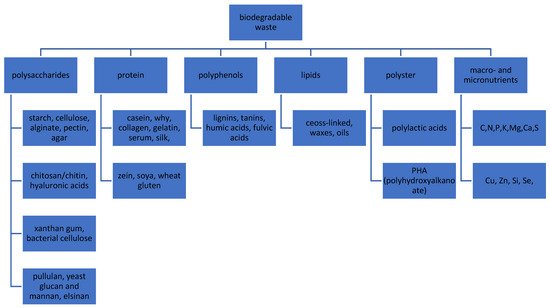
| Product | Biodegradable Waste |
|---|---|
| Compost Vermicompost Digestate Organic-mineral fertilizers Soil substitutes Plant growth promoting substrates Biochar Ash Struvite |
Food, agricultural, forest waste Pig, cow, poultry manure Sewage sludge Organic fraction of municipal solid waste (ofmsw) Waste from the food (such slaughterhouses, bakeries, dairies, breweries) Pulp and paper mill by-products Wastewater |
1.1. Compost
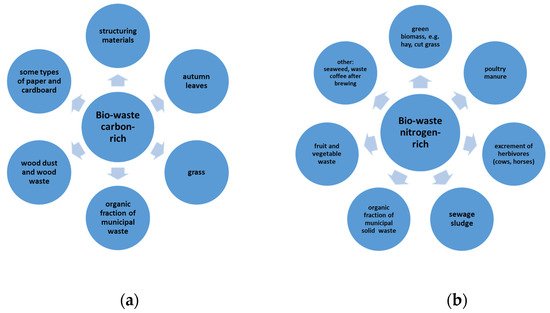
1.2. Organic–Mineral Fertilizers
-
Elimination of pathogens, as the product for natural use should be safe in terms of sanitation;
-
Correction and harmonization of the chemical composition and physical properties, as sewage sludge is a variable substrate;
-
Giving the fertilizer mixture a practical, usable and storable form.
1.3. Biochar
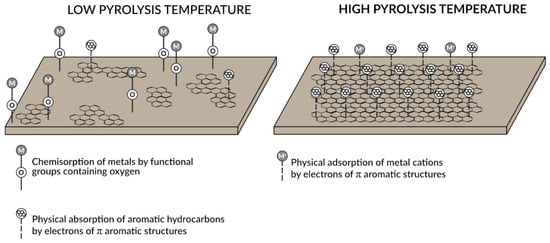
2. Advantages of Use the Biodegradable Waste on/to Degraded Soil
2.1. Soil Organic Matter (SOM)
2.2. Carbon Sequestration and Climate Mitigate
-
y is the annual net soil carbon sequestration (Mg C ha −1 yr −1),
-
x is annual biosolids application (Mg ha −1 yr −1, dry wt.).
2.3. Biodiversity and Microbial Activity
2.4. Plant Ecosystem Restoration
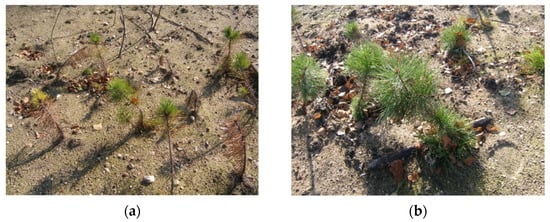
This entry is adapted from the peer-reviewed paper 10.3390/en15010385
References
- Communication from the Commission to the European Parliament, the Council, the European Economic and Social Committee and the Committee of the Regions towards a Circular Economy: A Zero Waste Programme for Europe/* COM/2014/0398 Final. Available online: https://eur-lex.europa.eu/legal-content/EN/TXT/?uri=celex%3A52014DC0398 (accessed on 11 November 2021).
- Regulation (EU) 2019/1009 of the European Parliament and of the Council of 5 June 2019 laying down rules on the making available on the market of EU fertilising products and amending Regulations (EC) No 1069/2009 and (EC) No 1107/2009 and repealing Regulation (EC) No 2003/2003. Off. J. Eur. Union. 2019, 170, 1–114.
- 161024 ECN Biowaste Recycling in Europe. Available online: https://www.compostnetwork.info/download/ecn-status-report-2019-european-bio-waste-management-overview-of-bio-waste-collection-treatment-markets-across-europe-2/ (accessed on 11 November 2021).
- Razza, F.; D’Avino, L.; L’Abate, G.; Lazzeri, L. The role of compost in bio-waste management and circular economy. In Designing Sustainable Technologies, Products and Policies; Springer: Cham, Switzerland, 2018; pp. 133–143.
- Zhang, D.; Luo, W.; Li, Y.; Wang, G.; Li, G. Performance of co-composting sewage sludge and organic fraction of municipal solid waste at different proportions. Bioresour. Technol. 2018, 250, 853–859.
- Jalili, M.; Mokhtari, M.; Eslami, H.; Abbasi, F.; Ghanbari, R.; Ebrahimi, A.A. Toxicity evaluation and management of co-composting pistachio wastes combined with cattle manure and municipal sewage sludge. Ecotoxicol. Environ. Saf. 2019, 171, 798–804.
- Ajmal, M.; Aiping, S.; Awais, M.; Ullah, M.S.; Saeed, R.; Uddin, S.; Ahmad, I.; Zhou, B.; Zihao, X. Optimization of pilot-scale in-vessel composting process for various agricultural wastes on elevated temperature by using Taguchi technique and compost quality assessment. Process Saf. Environ. Prot. 2020, 140, 34–45.
- Cerda, A.; Artola, A.; Font, X.; Barrena, R.; Gea, T.; Sánchez, A. Composting of food wastes: Status and challenges. Bioresour. Technol. 2018, 248, 57–67.
- Onwosi, C.O.; Igbokwe, V.C.; Odimba, J.N.; Eke, I.E.; Nwankwoala, M.O.; Iroh, I.N.; Ezeogu, L.I. Composting technology in waste stabilization: On the methods, challenges and future prospects. J. Environ. Manag. 2017, 190, 140–157.
- Meng, L.; Li, W.; Zhang, S.; Wu, C.; Lv, L. Feasibility of co-composting of sewage sludge, spent mushroom substrate and wheat straw. Bioresour. Technol. 2017, 226, 39–45.
- Jędrczak, A. Biological Treatment of Waste; Polish Scientific Publishers PWN: Warsaw, Poland, 2007; ISBN 978-83-01-15166-9. (In Polish)
- De Mendonça Costa, M.S.S.; Bernardi, F.H.; de Mendonça Costa, L.A.; Pereira, D.C.; Lorin, H.E.F.; Rozatti, M.A.T.; Carneiro, L.J. Composting as a cleaner strategy to broiler agro-industrial wastes: Selecting carbon source to optimize the process and improve the quality of the final compost. J. Clean. Prod. 2017, 142, 2084–2092.
- Cáceres, R.; Malińska, K.; Marfà, O. Nitrification within composting: A review. Waste Manag. 2018, 72, 119–137.
- Chen, M.; Huang, Y.; Liu, H.; Xie, S.; Abbas, F. Impact of different nitrogen source on the compost quality and greenhouse gas emissions during composting of garden waste. Process Saf. Environ. Prot. 2019, 124, 326–335.
- Koyama, M.; Nagao, N.; Syukri, F.; Abd Rahim, A.; Kamarudin, M.S.; Toda, T.; Mitsuhasi, T.; Nakasaki, K. Effect of temperature on thermophilic composting of aquaculture sludge: NH3 recovery, nitrogen mass balance, and microbial community dynamics. Bioresour. Technol. 2018, 265, 207–213.
- Li, M.X.; He, X.S.; Tang, J.; Li, X.; Zhao, R.; Tao, Y.Q.; Wang, C.; Qiu, Z.P. Influence of moisture content on chicken manure stabilization during microbial agent-enhanced composting. Chemosphere 2021, 264, 128549.
- Diaz, L.F.; Golueke, C.G.; Savage, G.M.; Eggerth, L.L. Composting and Recycling Municipal Solid Waste; CRC Press: Boca Raton, FL, USA, 2020.
- Barthod, J.; Rumpel, C.; Dignac, M.F. Composting with additives to improve organic amendments. A review. Agron. Sustain. Dev. 2018, 38, 17.
- Siebert, S. Bio-Waste Recycling in Europe against the Backdrop of the Circular Economy Package. Available online: https://www.compostnetwork.info/download/bio-waste-recycling-europe-backdrop-circular-economy-package/ (accessed on 21 November 2021).
- Longhurst, P.J.; Tompkins, D.; Pollard, S.J.; Hough, R.L.; Chambers, B.; Gale, P.; Tyrrel, S.; Villa, R.; Taylor, M.; Wu, S.; et al. Risk assessments for quality-assured, source-segregated composts and anaerobic digestates for a circular bioeconomy in the UK. Environ. Int. 2019, 127, 253–266.
- Massa, D.; Malorgio, F.; Lazzereschi, S.; Carmassi, G.; Prisa, D.; Burchi, G. Evaluation of two green composts for peat substitution in geranium (Pelargonium zonale L.) cultivation: Effect on plant growth, quality, nutrition, and photosynthesis. Sci. Hortic. 2018, 228, 213–221.
- Ali, M.; Griffiths, A.J.; Williams, K.P.; Jones, D.L. Evaluating the growth characteristics of lettuce in vermicompost and green waste compost. Eur. J. Soil Biol. 2007, 43, S316–S319.
- Chang, J.I.; Tsai, J.J.; Wu, K.H. Composting of vegetable waste. Waste Manag. Res. 2006, 24, 354–362.
- Kalamdhad, A.S.; Singh, Y.K.; Ali, M.; Khwairakpam, M.; Kazmi, A.A. Rotary drum composting of vegetable waste and tree leaves. Bioresour. Technol. 2009, 100, 6442–6450.
- Sarkar, S.; Pal, S.; Chanda, S. Optimization of a vegetable waste composting process with a significant thermophilic phase. Procedia Environ. Sci. 2016, 35, 435–440.
- Pergola, M.; Persiani, A.; Pastore, V.; Palese, A.M.; D’Adamo, C.; De Falco, E.; Celano, G. Sustainability assessment of the green compost production chain from agricultural waste: A case study in southern Italy. Agronomy 2020, 10, 230.
- Gupta, C.; Prakash, D.; Gupta, S.; Nazareno, M.A. Role of vermicomposting in agricultural waste management. In Sustainable Green Technologies for Environmental Management; Springer: Singapore, 2019; pp. 283–295.
- Picariello, E.; Pucci, L.; Carotenuto, M.; Libralato, G.; Lofrano, G.; Baldantoni, D. Compost and sewage sludge for the improvement of soil chemical and biological quality of Mediterranean agroecosystems. Sustainability 2021, 13, 26.
- Khaliq, S.J.A.; Al-Busaidi, A.; Ahmed, M.; Al-Wardy, M.; Agrama, H.; Choudri, B.S. The effect of municipal sewage sludge on the quality of soil and crops. Int. J. Recycl. Org. Waste Agric. 2017, 6, 289–299.
- Wei, Y.; Li, J.; Shi, D.; Liu, G.; Zhao, Y.; Shimaoka, T. Environmental challenges impeding the composting of biodegradable municipal solid waste: A critical review. Resour. Conserv. Recycl. 2017, 122, 51–65.
- Soobhany, N. Preliminary evaluation of pathogenic bacteria loading on organic Municipal Solid Waste compost and vermicompost. J. Environ. Manag. 2018, 206, 763–767.
- Grobelak, A.; Stępień, W.; Kacprzak, M. Sewage sludge as an ingredient in fertilizers and soil substitutes. Ecol. Eng. 2016, 48, 52–60.
- Poluszyńska, J. Possibilities of applications of fly ash from the biomass combustion in the sludge management. Sci. Work. Inst. Ceram. Build. Mater. 2013, 13, 48–59. (In Polish)
- Sizmur, T.; Quilliam, R.; Puga, A.P.; Moreno-Jiménez, E.; Beesley, L.; Gomez-Eyles, J.L. Application of Biochar for Soil Remediation. Agricultural and Environmental Applications of Biochar: Advances and Barriers; Guo, M., He, Z., Uchimiya, M., Eds.; SSSA Special Publication (SSSA): Madison, WI, USA, 2015; Volume 63.
- Garcia, C.; Hernandez, T.; Coll, M.D.; Ondoño, S. Organic amendments for soil restoration in arid and semiarid areas: A review. AIMS Environ. Sci. 2017, 4, 640–676.
- Soria, R.; González-Pérez, J.A.; de la Rosa, J.M.; San Emeterio, L.M.; Domene, M.A.; Ortega, R.; Miralles, I. Effects of technosols based on organic amendments addition for the recovery of the functionality of degraded quarry soils under semiarid Mediterranean climate: A field study. Sci. Total Environ. 2021, 151572, in press.
- Arif, M.S.; Riaz, M.; Shahzad, S.M.; Yasmeen, T.; Ashraf, M.; Siddique, M.; Mubarik, M.S.; Bragazza, L.; Buttler, A. Fresh and composted industrial sludge restore soil functions in surface soil of degraded agricultural land. Sci. Total Environ. 2018, 619–620, 517–527.
- Kacprzak, M. Wspomaganie procesów remediacji terenów zdegradowanych. Wydawnictwo. Politechniki Czestochowskiej. 2007, 128. (In Polish)
- Ayilara, M.S.; Olanrewaju, O.S.; Babalola, O.O.; Odeyemi, O. Waste Management through Composting: Challenges and Potentials. Sustainability 2020, 12, 4456.
- Leogrande, R.; Vitti, C. Use of organic amendments to reclaim saline and sodic soils: A review. Arid. Land Res. Manag. 2018, 33, 1–21.
- Hueso-González, P.; Muñoz-Rojas, M.; Martínez-Murillo, J.F. The role of organic amendments in drylands restoration. Curr. Opin. Environ. Sci. Health 2018, 5, 1–6.
- Meena, M.D.; Yadav, R.K.; Narjary, B.; Yadav, G.; Jat, H.S.; Sheoran, P.; Meena, M.K.; Antil, R.S.; Meena, B.L.; Singh, H.V.; et al. Municipal solid waste (MSW): Strategies to improve salt affected soil sustainability: A review. Waste Manag. 2019, 84, 38–53.
- Olsson, L.; Barbosa, H.; Bhadwal, S.; Cowie, A.; Delusca, K.; Flores-Renteria, D.; Hermans, K.; Jobbagy, E.; Kurz, W.; Li, D.; et al. Land Degradation. In Climate Change and Land: An IPCC Special Report on Climate Change, Desertification, Land Degradation, Sustainable Land Management, Food Security, and Greenhouse Gas Fluxes in Terrestrial Ecosystems; Shukla, P.R., Skea, J., Buendia, E.C., Masson-Delmotte, V., Pörtner, H.-O., Roberts, D.C., Zhai, P., Slade, R., Connors, S., van Diemen, R., Eds.; IPPC: Rome, Italy, 2019.
- Navarro-Pedreño, J.; Almendro-Candel, M.B.; Zorpas, A.A. The Increase of Soil Organic Matter Reduces Global Warming, Myth or Reality? Science 2021, 3, 18.
- Montanarella, L.; Panagos, P. The relevance of sustainable soil management within the European Green Deal. Land Use Policy 2021, 100, 104950.
- Rusco, E.; Jones, R.J.; Bidoglio, G. Organic matter in the soils of Europe: Present status and future trends. In JRC, Official Publications of the European Communities; European Communities: Brussels, Belgium, 2001.
- Ngo, P.-T.; Rumpel, C.; Thu, T.D.; Henry-des-Tureaux, T.; Dang, D.-K.; Jouquet, P. Use of organic substrates for increasing soil organic matter quality and carbon sequestration of tropical degraded soil: A 3-year mesocosms experiment. Carbon Manag. 2014, 5, 155–168.
- Mekki, A.; Aloui, F.; Sayadi, S. Influence of biowaste compost amendment on soil organic carbon storage under arid climate. J. Air Waste Manag. Assoc. 2019, 69, 867–877.
- Minasny, B.; Malone, B.P.; McBratney, A.B.; Angers, D.A.; Arrouays, D.; Chambers, A.; Chaplot, V.; Chen, Z.S.; Cheng, K.; Das, B.S.; et al. Soil carbon 4 per mille. Geoderma 2017, 292, 59–86.
- Lal, R. Management of Carbon Sequestration in Soil; CRC Press: Boca Raton, FL, USA, 2019.
- Lin, Y.; Ye, G.; Kuzyakov, Y.; Liu, D.; Fan, J.; Ding, W. Long-term manure application increases soil organic matter and aggregation, and alters microbial community structure and keystone taxa. Soil Biol. Biochem. 2019, 134, 187–196.
- Zang, H.; Blagodatskaya, E.; Wang, J.; Xu, X.; Kuzyakov, Y. Nitrogen fertilization increases rhizodeposit incorporation into microbial biomass and reduces soil organic matter losses. Biol. Fertil. Soils 2017, 53, 419–429.
- Paustian, K.; Lehmann, J.; Ogle, S.; Reay, D.; Robertson, G.P.; Smith, P. Climate-smart soils. Nature 2016, 532, 49–57.
- Tian, G.; Granato, T.C.; Cox, A.E.; Pietz, R.I.; Carlson, C.R.; Abedin, Z. Soil carbon sequestration resulting from long-term application of biosolids for land reclamation. J. Environ. Qual. 2009, 38, 6174.
- Placek, A.; Grobelak, A.; Włóka, D.; Kowalska, A.; Singh, B.R.; Almas, A.; Kacprzak, M. Methods for calculating carbon sequestration in degraded soil of zinc smelter and post-mining areas. Desalination Water Treat. 2018, 134, 233–243.
- Kacprzak, M.; Stańczyk–Mazanek, E. Changes in the structure of fungal communities of soil treated with sewage sludge. Biol. Fertil. Soils 2003, 38, 89–95.
- Kacprzak, M.; Woszczyk, K. The microfungal communities in sewage sludge treated soils. Environ. Prot. Eng. 2004, 30, 51–56.
- Kizilkaya, R.; Bayrakh, B. Effects of N-enriched sewage sludge on soil activities. Appl. Soil Ecol. 2005, 30, 192–202.
- Kowalska, A.; Grobelak, A.; Almås, Å.R.; Singh, B.R. Effect of Biowastes on Soil Remediation, Plant Productivity and Soil Organic Carbon Sequestration: A Review. Energies 2020, 13, 5813.
- Khan, M.A.; Ding, X.; Khan, S.; Brusseau, M.L.; Khan, A.; Nawab, J. The influence of various organic amendments on the bioavailability and plant uptake of cadmium present in mine-degraded soil. Sci. Total Environ. 2018, 636, 810–817.
- Sun, Y.; Xiong, X.; He, M.; Xu, Z.; Hou, D.; Zhang, W.; Ok, Y.S.; Rinklebe, J.; Wang, L.; Tsang, D.C.W. Roles of biochar-derived dissolved organic matter in soil amendment and environmental remediation: A critical review. Chem. Eng. J. 2021, 424, 130387.
- Barbosa, B.; Fernando, A.L. Chapter 9—Aided phytostabilization of mine waste. In Bio-Geotechnologies for Mine Site Rehabilitation; Prasad, M.N.V., de Favas, P.J., Maiti, S.K., Eds.; Elsevier: Amsterdam, The Netherlands, 2018; pp. 147–157.
- Larkin, R.P. Soil Health Paradigms and Implications for Disease Management. Annu. Rev. Phytopathol. 2015, 53, 10.1–10.23.


